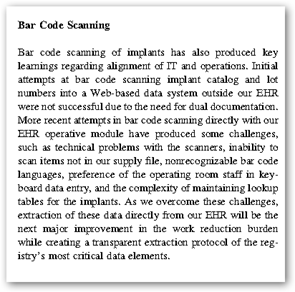The press release follows below. Not to steal any thunder here but look at what is being developed to work with the registry and PHR – bar codes. If you are a regular reader here you know what the focus is on my campaign for a bar coding system for recalls, drug identification and more. Kaiser Permanente has done a great job working with knees and hips with their patient registry, being able to not only fit the appropriate device, but also the ability to notify the patient of any safety concerns and recalls through their coordination of information. The coordinated use of the PHR, the personal health record for patient information can identify the current state of health for the patient up front, thus fewer or no  surprises when going into surgery.
surprises when going into surgery.
In my opinion they have taken the first step as a model for the rest of the country to get on the band wagon here and I would like to hope that the FDA, the DEA, as well as drug and device companies would begin to entertain a system that would work for everyone. It would be nice to have the availability for not only healthcare professionals but consumers as well to be able to use a cell phone to scan a bar code and get real time information. If you want to learn more about bar coding and tags in healthcare use the link below and you can also find the permanent post on the blog in the heading. Bar code solutions are the future in healthcare and they can connect to PHRs and authenticate physicians for e-prescribing too. I have included a couple screenshots from the study with the focus on bar coding and using HeatlhConnect, the personal health records.
Microsoft Tags – Microsoft MSDN Posts Ideas from the Medical Quack About Use in Healthcare!
Nice work on the part of Kaiser Permanente with using information and technology to create the best solution for the patient through personal  health records and a registry with statistics to project and produce the best fit and outcome for the patient. BD
health records and a registry with statistics to project and produce the best fit and outcome for the patient. BD
Press Release:
July 22, 2010 (Oakland, Calif.) – A total joint replacement registry based on carefully designed and integrated technology can enhance patient safety, quality of care, cost-effectiveness and research, according to a paper published in the online and print editions of Clinical Orthopedics and Related Research, a journal of the Association of Bone and Joint Surgeons.
Kaiser Permanente’s Total Joint Replacement Registry– the nation’s largest such registry -- allows caregivers to analyze specific data from standardized forms and Kaiser Permanente HealthConnect®, an electronic health record, on more than 100,000 joint replacement cases by more than 350 Kaiser Permanente surgeons nationwide.
Since its inception in 2001, the TJRR has helped health care providers identify best practices, evaluate risk factors associated with revision surgeries, and assess the clinical effectiveness of implants. It also provides information that can be used to study patient demographics, implant characteristics and surgical techniques in relationship to post-operative complications such as infections, revisions and re-operations.
The TJRR also allows Kaiser Permanente to immediately identify and notify patients about recalled or defective implants prior to an official recall notice. The TJRR was instrumental in assessing more than 15 advisories and concerns with implants in 2009 alone. 
In the article, the authors share insights from the organization’s experience in developing, implementing and integrating the registry into KP HealthConnect, a comprehensive health information system that is one of the most advanced and largest private sector electronic health records in the world, securely connecting 8.6 million people to their health care teams.
“To be successful, a large registry must have physician involvement, integration into workflow including rigorous validation and quality control methods, and provide ongoing feedback to participating surgeons and staff,” said paper lead author Elizabeth Paxton, director of surgical outcomes and analysis at Kaiser Permanente. “Having used our registry to conduct research and translate these findings into actionable clinical-care guidelines, our total joint replacement registry shows that a national registry has the potential to improve patient safety and quality across the industry.”
By analyzing information included in the registry, researchers found that younger patients, those with diabetes, and patients with diagnoses other than osteoarthritis (e.g. post-traumatic and rheumatoid arthritis) were at higher risk for revision total joint surgery. This information has been integrated into a risk calculator for surgeons and patients to use in making decisions about treatment. Research from the registry on implants and surgical techniques also has influenced changes in clinical practice, which have resulted in optimization of both techniques and implants.
“Within the United States, more than 600,000 total joint replacement procedures are performed each year, and the volume and costs associated with these procedures are projected to increase dramatically over the next 20 years,” said Monti Khatod, MD, paper co-author and orthopedic surgeon at Kaiser
Permanente in Baldwin Park, Calif. “Our registry allows health care professionals and other researchers to evaluate ways to be more efficient while enhancing quality and assessing new technology in order to determine which implants are best for our patients.”
Authors of the paper include Elizabeth W. Paxton, MA and Maria C.S. Inacio, MS, from Kaiser Permanente’s Surgical Outcomes and Analysis Unit of Clinical Analysis in San Diego; Monti Khatod, MD, from Kaiser Permanente Baldwin Park Medical Center; Eric J. Yue, MD, from Kaiser Permanente Sacramento; and Robert S. Namba, MD, from Kaiser Permanente Orange County.
Read more about The Total Joint Replacement Registry at:
http://xnet.kp.org/permanentejournal/NIR/
About Kaiser Permanente
Kaiser Permanente is committed to helping shape the future of health care. We are recognized as one of America's leading health care providers and not-for-profit health plans. Founded in 1945, our mission is to provide high-quality, affordable health care services and to improve the health of our members and the communities we serve. We currently serve 8.6 million members in nine states and the District of Columbia. Care for members and patients is focused on their total health and guided by their personal physicians, specialists and team of caregivers. Our expert and caring medical teams are empowered and supported by industry-leading technology advances and tools for health promotion, disease prevention, state-of-the art care delivery and world-class chronic disease management. Kaiser Permanente is dedicated to care innovations, clinical research, health education and the support of community health. For more information, go to: www.kp.org/newscenter.




Original investigations of Kaiser Permanente fraud,corruption,rationing,and false advertising are posted on www.hmohardball.com
ReplyDeleteRobert D. Finney, Ph.D.